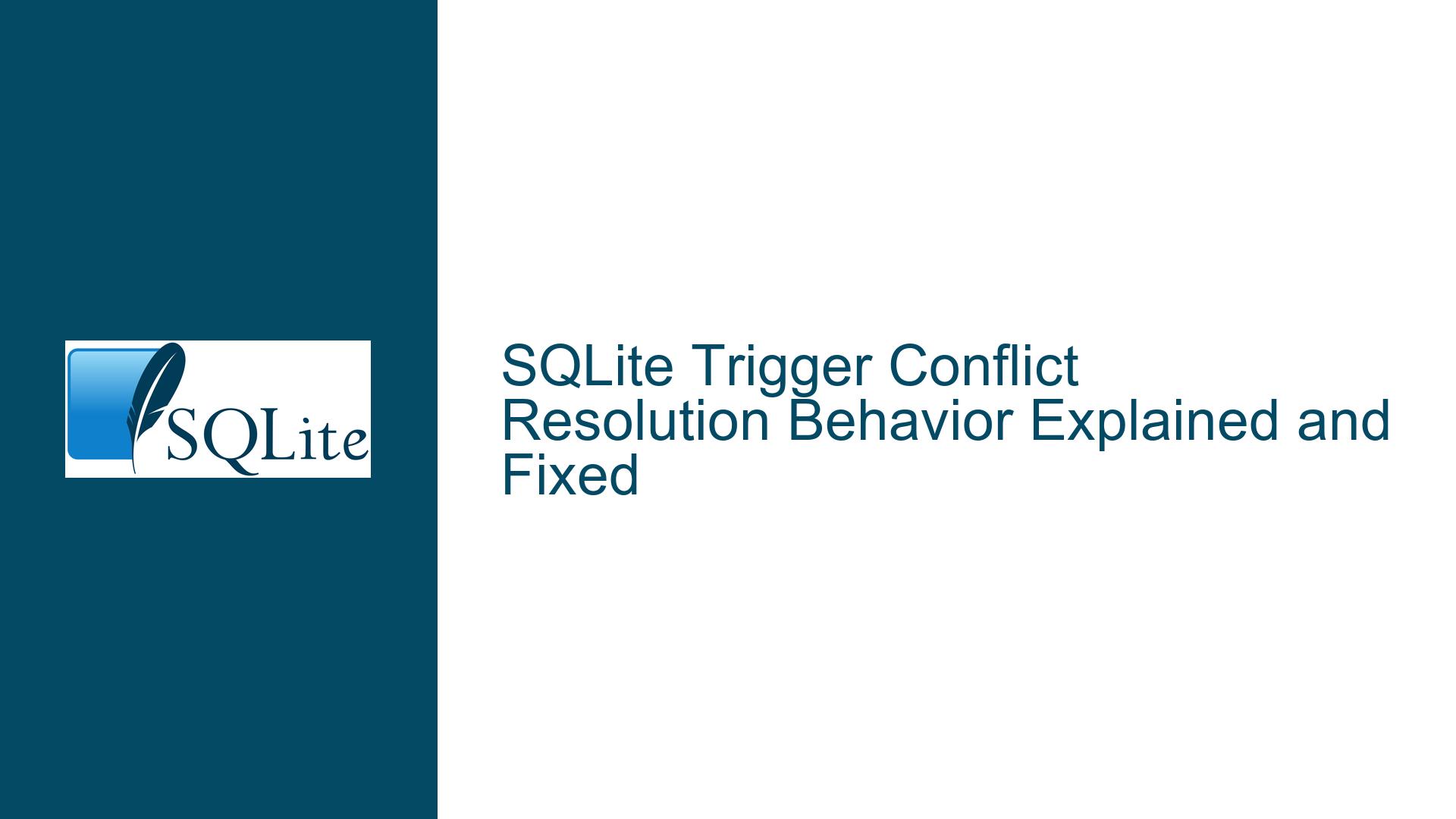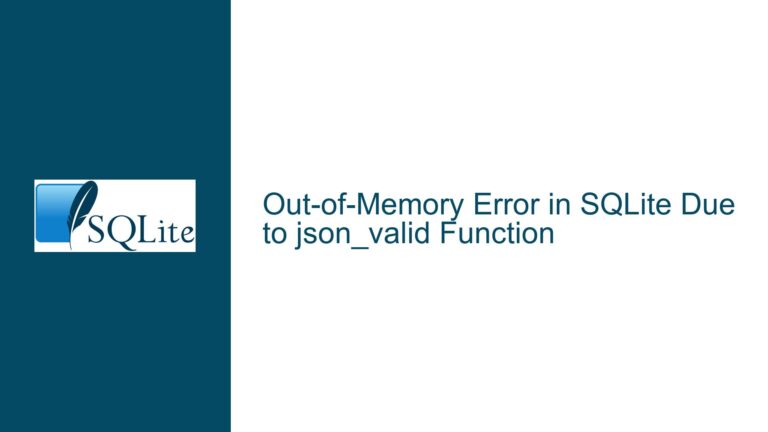SQLite Trigger Conflict Resolution Behavior Explained and Fixed
SQLite Trigger Conflict Resolution Overrides Inner Conflict Handling
When working with SQLite triggers, one of the most nuanced and often misunderstood behaviors is how conflict resolution methods propagate between the outer statement and the inner trigger logic. Specifically, the conflict resolution method specified in the outer statement (e.g., INSERT OR REPLACE) can override the conflict resolution method specified within the trigger (e.g., INSERT OR IGNORE). This behavior is documented in the SQLite manual but is frequently overlooked, leading to unexpected results in database operations.
In the provided scenario, a trigger is designed to increment a counter in a secondary table (counter_table) whenever a row is inserted into the primary table (contacts). The trigger uses INSERT OR IGNORE to ensure that a row with a specific ID (10) is created in counter_table if it does not already exist. However, when the outer statement uses INSERT OR REPLACE, the IGNORE conflict resolution within the trigger is overridden by the REPLACE method. This results in the row in counter_table being replaced instead of being ignored, which disrupts the counter increment logic.
This behavior is rooted in SQLite’s conflict resolution hierarchy, where the outer statement’s conflict resolution method takes precedence over any conflict resolution specified within the trigger. This design ensures consistency in how conflicts are handled across nested operations but can lead to confusion if not properly understood.
Outer Statement Conflict Resolution Overriding Trigger Logic
The core issue arises from the interaction between the outer statement’s conflict resolution method and the trigger’s internal conflict handling. When an outer statement such as INSERT OR REPLACE is executed, it sets the conflict resolution context for the entire operation, including any triggers that are fired as a result of the statement. This means that any INSERT OR IGNORE statements within the trigger are effectively converted to INSERT OR REPLACE if the outer statement specifies REPLACE.
In the example, the trigger is designed to insert a row into counter_table with a default value of 0 if the row does not already exist. The subsequent UPDATE statement increments the counter. However, because the outer statement uses INSERT OR REPLACE, the INSERT OR IGNORE within the trigger is overridden, and the row in counter_table is replaced instead of being ignored. This replacement resets the counter to 0 before the increment operation, leading to incorrect results.
This behavior is particularly problematic in scenarios where the trigger logic relies on the IGNORE conflict resolution to avoid overwriting existing data. When the outer statement’s conflict resolution method overrides the trigger’s logic, it can lead to data inconsistencies and unexpected behavior.
Implementing UPSERT and Alternative Trigger Logic for Correct Conflict Handling
To address this issue, there are two primary solutions: using the UPSERT syntax or rewriting the trigger logic to avoid reliance on conflict resolution methods that can be overridden by the outer statement.
Solution 1: Using UPSERT Syntax
The UPSERT syntax, introduced in SQLite 3.24.0, provides a more robust way to handle conflicts within triggers. By using INSERT ... ON CONFLICT, you can explicitly define how conflicts should be handled at the row level, independent of the outer statement’s conflict resolution method. Here is how the trigger can be rewritten using UPSERT:
CREATE TRIGGER trigger1 AFTER INSERT ON contacts
BEGIN
INSERT INTO counter_table (id, counter)
VALUES (10, 1)
ON CONFLICT(id) DO UPDATE SET counter = counter + 1;
END;
In this version, the INSERT statement explicitly handles conflicts by incrementing the counter if a row with the specified ID already exists. This approach ensures that the counter is correctly incremented regardless of the outer statement’s conflict resolution method.
Solution 2: Rewriting Trigger Logic to Avoid Conflict Resolution Overrides
If you are using a version of SQLite that does not support UPSERT, or if you prefer to avoid using it, you can rewrite the trigger logic to explicitly check for the existence of the row before performing the insert. This approach avoids the need for conflict resolution altogether:
CREATE TRIGGER trigger1 AFTER INSERT ON contacts
BEGIN
INSERT INTO counter_table (id, counter)
SELECT 10, 0
WHERE NOT EXISTS (SELECT 1 FROM counter_table WHERE id = 10);
UPDATE counter_table SET counter = counter + 1 WHERE id = 10;
END;
In this version, the INSERT statement is only executed if a row with the specified ID does not already exist in counter_table. This ensures that the row is not overwritten, and the subsequent UPDATE statement correctly increments the counter.
Detailed Comparison of Solutions
| Solution | Pros | Cons |
|---|---|---|
| UPSERT Syntax | – Explicit conflict handling at the row level – Cleaner and more concise syntax – Works independently of outer statement conflict resolution | – Requires SQLite 3.24.0 or later – May be less intuitive for developers unfamiliar with UPSERT |
| Rewritten Trigger Logic | – Compatible with all versions of SQLite – Avoids reliance on conflict resolution methods – More explicit control over logic flow | – More verbose and complex syntax – Requires additional query to check for row existence |
Additional Considerations
When implementing either solution, it is important to consider the following:
Performance Implications: The
UPSERTsyntax is generally more efficient because it combines the insert and update operations into a single statement. The rewritten trigger logic, while functional, requires an additional query to check for row existence, which can impact performance in high-throughput scenarios.Atomicity: Both solutions ensure atomicity at the statement level, but the
UPSERTsyntax provides a more straightforward way to handle conflicts without risking data inconsistencies.Maintainability: The
UPSERTsyntax is easier to maintain and understand, especially for developers who are familiar with modern SQL features. The rewritten trigger logic, while effective, may be more difficult to debug and modify in the future.Compatibility: If your application needs to support older versions of SQLite, the rewritten trigger logic is the only viable option. However, if you can require SQLite 3.24.0 or later, the
UPSERTsyntax is the recommended approach.
Practical Example
To illustrate the difference between the two solutions, consider the following sequence of operations:
- Initial State:
counter_tableis empty. - First Insert:
INSERT INTO contacts VALUES (5, 'A');- UPSERT Solution:
counter_tablenow contains(10, 1). - Rewritten Trigger Logic:
counter_tablenow contains(10, 1).
- UPSERT Solution:
- Second Insert:
INSERT OR REPLACE INTO contacts VALUES (5, 'B');- UPSERT Solution:
counter_tablenow contains(10, 2). - Rewritten Trigger Logic:
counter_tablenow contains(10, 2).
- UPSERT Solution:
Both solutions produce the correct result, but the UPSERT syntax achieves this with fewer queries and less complexity.
Conclusion
Understanding how conflict resolution methods propagate between outer statements and triggers is crucial for writing reliable and maintainable SQLite code. By using the UPSERT syntax or rewriting trigger logic to avoid conflict resolution overrides, you can ensure that your database operations behave as expected, even in complex scenarios. Always consider the trade-offs between performance, maintainability, and compatibility when choosing the best approach for your application.






